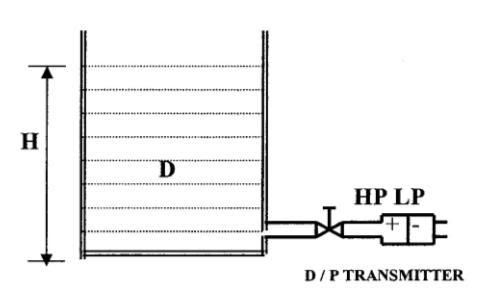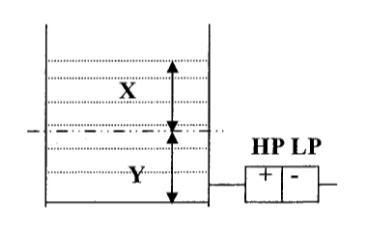Answering the question in how to do it, see the picture below. The bottom area of the vessel is connected to the high pressure side of the differential pressure meter or transmitter.
Differential Pressure = H x D
 The diffferential pressure is applied to the high pressure side of the transmitter and is calibrated.
The diffferential pressure is applied to the high pressure side of the transmitter and is calibrated.How is D.P. transmitter applied to a close tank?
In close tank the bottom of the tank is connected to the high pressure side of the transmitter and top of the tank in connected to L.P. side of the transmitter. In this way the vessel pressure is balanced.
How is D.P. transmitter applied to an open tank?
On an open tank level measurement the L.P. side is vented to atmosphere. Whatever pressure acts is on the H.P. side which is a measure of level.
 SPAN = (X) ()
SPAN = (X) ()ZERO SUPPRESSION = (Y) (Specific Gravity)
Also, how can a differential pressure transmitter be applied to a close and open tank with Dry Leg to measure level?
Considering the formula below;
Span = (X) (GL)
Hw at minimum level - (Z)(GS) + (Y)(GL)
Hw at maximum level = ( Z ) ( Gs ) + (X + Y) ( GL)
Where:
GL= Specific gravity of tank liquid
Gs = Specific gravity of seal liquid
Hw = Equivalent head of water
X, Y & Z are shown below
 Example:
Example:Open tank with:
- X =300 inches
- Y =50 inches
- Z =10 inches
- GL= 0.8
- Gs= 0.9
- Span = (300) (0.8) = 240 inches
Hw at minimum level = ( 10 ) ( 0.9 ) + ( 50 ) ( 0.8 ) = 49 inches
Hw at maximum level = (10 ) ( 0.9 ) + ( 50 + 300 ) ( 0.8 ) = 289 inches
Calibrated range = 49 to 289 inches head of water


